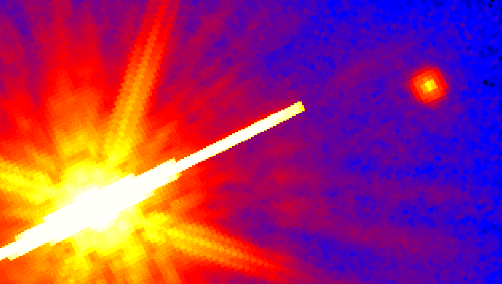Explanation: Is the dim star to the upper right of this false-color picture the coolest possible normal star? From this recent picture by the Hubble Space Telescope, astronomers have estimated its mass is just high enough for it to fuse hydrogen into helium in its core. In general, the higher an object's mass, the higher it's core density and temperature. Above a certain point, the intense core conditions cause hydrogen atoms to move so fast that many stick or "fuse" after collision, releasing enormous amounts of energy. Were this object less massive, the object would shine by gravitational contraction and so be termed a "brown dwarf" rather than a normal main-sequence "star." The star on the left is so much brighter than the "coolest star" that it creates the white streak and dramatic pattern visible in the image. More information is given by the Space Telescope Scientific Institute's press release.
1999 2000 2001 2002 2003 2004 2005 2006 2007 2008 2009 2010 2011 2012 2013 2014 2015 2016 2017 2018 2019 2020 2021 2022 2023 2024 2025 |
Январь Февраль Март Апрель Май Июнь Июль Август Сентябрь Октябрь Ноябрь Декабрь |
NASA Web Site Statements, Warnings, and Disclaimers
NASA Official: Jay Norris. Specific rights apply.
A service of: LHEA at NASA / GSFC
& Michigan Tech. U.
|
Публикации с ключевыми словами:
star - звезды - термоядерные реакции
Публикации со словами: star - звезды - термоядерные реакции | |
См. также:
Все публикации на ту же тему >> | |
